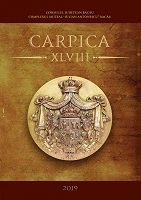Conștiința de neam a românilor evidențiată în momente istorice semnificative
The national consciousness of the Romanian people, highlighted in significant historical moments
Author(s): Ioan UngureanuSubject(s): Cultural Anthropology / Ethnology, Nationalism Studies, 15th Century, 17th Century
Published by: Complexul Muzeal “Iulian Antonescu” Bacău
Keywords: national consciousness; Romanian people; geographic space;
Summary/Abstract: In may 1600, Mihai Viteazul achieved the first political union of the three Romanian countries, calling himself „Ruler of Wallachia, Transylvania and the whole of Moldavia”, thus having an overwhelming role in transforming the consciousness of unity of nation and language of the Romanian people. The national consciousness of the Romanian people was also manifested during the Great Național Assembly from Blaj within 15th and 17th May 1848, with the participation of over 40.000 people at the Revoluțion of 1848. A great event of the național consciousness is the decisions of the Electoral Assemblies of Moldavia and Walachia, which established on 5th and 24th January 1859, the Union of the Romanian Principalities by electing Alexandru Ioan Cuza as the Ruling Prince. The idea of unity of the Romanian people will be crowned by by the Great Național Assembly in Alba Iulia, on 1st December 1918; on 27th April 1918, Bessarabia was united with Romania and on 30th November 1918, Bukovina was united with Romania.
Journal: Carpica
- Issue Year: 2020
- Issue No: XLIX
- Page Range: 182-190
- Page Count: 9
- Language: Romanian

